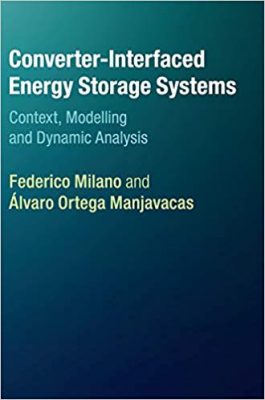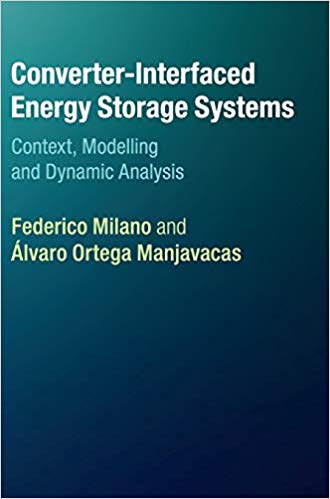 Authors: Federico Milano and Alvaro Ortega Manjavacas
Authors: Federico Milano and Alvaro Ortega Manjavacas
Publisher: Cambridge University Press – 368 pages
Book Review by: Venkat Subramaniam
This book by its two authors named above takes a look at a variety of storage systems for energy.
Written for anyone interested to learn about (or fill their knowledge gaps on) energy storage systems, this book would be particularly useful to energy professionals, researchers and graduate students on power system dynamics, renewable energy integration and smart development.
Storage is essential for conserving goods and data in various types of spaces and machines that make human life easier. Here are just a few examples: warehouses are used for holding a variety of products, computers for storing data, Internet networks for concentrated groups of data, and phones for storing conversations and voicemail messages.
In other sectors of life, there are needs for storage as well, such as cells in our bodies that store fat that can be converted to energy with physical activity, a fuel tank in cars with combustion engines, and much more.
This book has as its focus electric system applications, particularly those systems with energy storage technologies that are able to cycle the energy.
We provide for you below the titles of its four Parts and the chapters within them as a bird’s eye view of what you will find within:
- Part I – Context
- Need for Energy Storage
- Technical and Economic Aspects
- Energy Storage Technologies
- Part II – Modeling
- Power System Model
- Voltage-Sourced Converter Model
- Energy-Storage System Models
- Part III – Dynamic Models
- Comparison of Dynamic Models
- Control Techniques
- Stability Analysis
- Part IV – Appendices
Appendix A Numerical Integration
A.1 – Numerical Integration of Differential Algebraic Equations
A.2 – Numerical Integration of Stochastic Differential Algebraic Equations
Appendix B Park Transform
B.1 From abc to dqo
B.2 From dqo to abc
B.3 Time Derivatives of the Park Tensor
B.4 Clarke Transform
B.5 Park Vector
B 6 Angular Speed of the Park Transform
Appendix C Frequency Signals
C.1 Center of Inertia
C.2 Frequency Divider
C.3 Examples
Appendix D Data
D.1 WSCC 9-bus System
D.2 New England 39-bus System
D.3 Energy Storage System
Appendix E Irish Transmission System
Below in a nutshell, are some of the particular actionable benefits of owning this book:
- Gain an in-depth understanding of state-of-the-art converter-interfaced energy storage systems, covering dynamic behavior, modeling, stability analysis and control
- Get to know on an in-depth basis, the conceptual, technical and economic frameworks underpinning energy storage in modern power systems
- Go through a comprehensive review of technologies for cutting-edge converter-interfaced energy storage systems
- Garner knowledge about the impact of energy-storage systems on the dynamic interaction of micro-grids with transmission and distribution systems
- Generalized models for energy storage systems are also provided in this valuable book, that provide a variety of reference models
This book provides a lot dynamic simulation, mathematical examples and supporting data.
To those unfamiliar with the promise of recent developments in energy storage technology, this book is a must-read. As a conclusion, we provide you some important excerpts:
“Despite mixed feelings, the booming of energy storage technologies…In the real world, that is, outside academia and symposia, the years from 2010 2o 2017 have been an extraordinary period of intense brainstorming and experimentation on energy storage solutions. Existing technologies, such as batteries, have been and are being continuously improved in terms of duration and reliability. One of the most well-known outcomes of this research is the exponential growth of hybrid and plug-in electric vehicles. New, very often imaginative, prototypes that exploit a new chemical reaction or a new surprising solution came out on a monthly, if not on a weekly, basis.”
This is an important and pioneering book on emerging energy storage technologies by Federico Milano and Alvaro Ortega Manjavacas. Great work, and we all should be very excited about possible new products coming out fromthis growing field of research.
Authors:
Federico Milano is Professor of Power Systems Control and Protection and Head of Electrical Engineering at University College Dublin in Dublin, Ireland. He is a Fellow of the Institute of Electrical and Electronic Engineers (IEEE) and the Institute of Engineering Technology (IET).
Alvaro Ortega Manjavacas is a Senior Power Systems Researcher in the School of Electrical and Electronic Engineering at University College Dublin in Dublin, Ireland.







